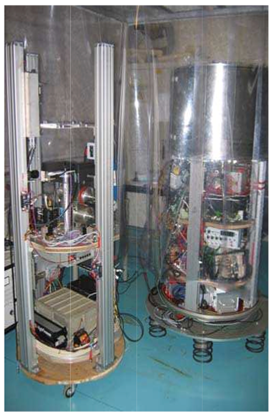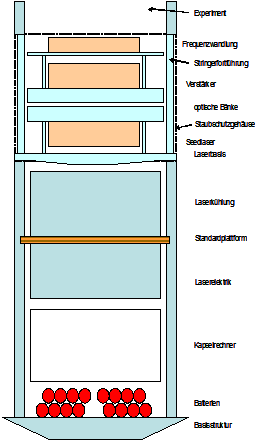advanced disk laser for combustion experiments in microgravity (ADL)

research area: combustion
experiment title:
Technical testing and validation of scientific possibilities of a laser system suited for applications in drop towers
experiment acronym: ADL
funding agency: DLR
grant number: 50WP0407
performing organization:
Institut für Physikalische Hochtechnologie e.V. (IPHT), Bereich Lasertechnik, Jena
prime investigator: Prof. Dr. Wolfgang Triebel
experiment objective
1. State of the art: There exist no lasers suited for laser induced fluorescence (LIF) under microgravity (μg). Available lasers either do not exhibit the required parameters or have to be ruled out because of dimensions or the required media supplies.
2. Scope: A newly developed laser system, which is – due to compactness, robustness and efficiency – well suited for applications in drop capsules has to be tested in the drop tower and validated for scientific capabilities. Optimization and additional measurements are conducted at the IPHT Jena.
3. Method: The chosen laser is a disk laser developed for drop tower applications. The high pulse energy and a repetition rate of 1 kHz are generated in a disk laser amplifier. Yb:YAG as the laser active medium offers a high tunability and a high efficiency due to optical pumping by high power laser diodes. The LIF relevant UV spectral range is available after frequency conversion. The laser, which was integrated into a drop capsule, was validated for all relevant wavelengths during drop tower experiments.
Special attention was given to possible scientific applications. The unique parameters of the laser system were demonstrated at combustion experiments with OH-radicals at the drop tower.
4. Results: The objectives (points 2) and 3) ) have been reached. Besides a sum of unexpected problems (see report), the operation of the laser at the fundamental as well as after second and third harmonics generation could be assured. Flushing the pump modules with helium opened up new perspectives for the use in drop tower applications as well as for lasers at extreme power requirements. LIF of OH-radicals was demonstrated successfully for the first time under μg-conditions with a kHz repetition rate.
5. Applications: The achieved results – in combination with first experiments at the laboratory laser system – are the basis for applications in further scientific projects. Though the laser system requires an experienced operator, it will extend essentially the
laser based combustion diagnostics at drop towers.
related publications
- Wolfgang Paa, Dirk Müller, Annett Gawlik, Wolfgang Triebel, Combined Multispecies PLIF Diagnostics with kHz Rate in a Technical Fuel Mixing System Relevant for Combustion Processes, SPIE-Tagung „Optics & Photonics 2005“, San Diego, Proc. SPIE, Vol. 5880, Paper No. 58800N-1
- A. Baum, D. Grebner, W. Paa, W. Triebel, M. Larionov, A. Giesen, Axial mode tuning of a single frequency Yb:YAG thin disk laser, Appl. Phys. B 81, 1091 – 1096 (2005)
- W. Paa, D. Müller, H. Stafast, W. Triebel, Flame turbulences recorded at 1 kHz using planar laser induced fluorescence upon hot band excitation of OH radicals, Appl. Phys. B 86, 1 – 5 (2007)
- M. Frank, W. Paa, W. Triebel, M. Schnepp, H. Stafast, Fast wavelength-switching of a diode-pumped solid-state disk laser, Appl. Phys. B 94: 65 – 69 (2009)
experimental setup


experiment campaigns
experiment year: 2007
number of drops: 13
experiment year: 2006
number of drops: 8
experiment year: 2005
number of drops: 21
experiment year: 2003
number of drops: 5


 "
"